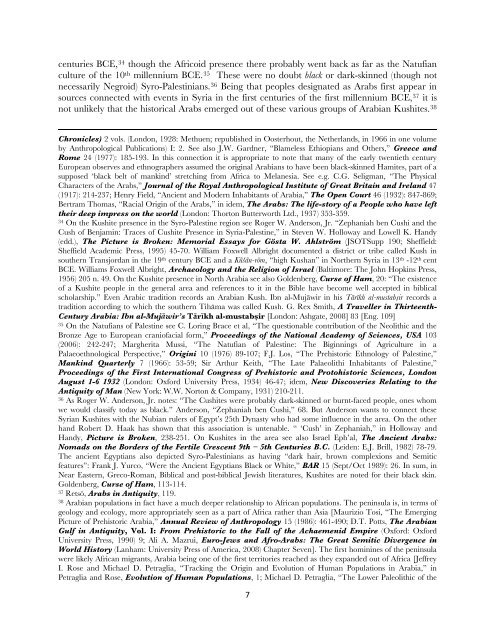“Anyone who says that the Prophet is black should be killed”: The ...
“Anyone who says that the Prophet is black should be killed”: The ...
“Anyone who says that the Prophet is black should be killed”: The ...
Create successful ePaper yourself
Turn your PDF publications into a flip-book with our unique Google optimized e-Paper software.
centuries BCE, 34 though <strong>the</strong> Africoid presence <strong>the</strong>re probably went back as far as <strong>the</strong> Natufian<br />
culture of <strong>the</strong> 10 th millennium BCE. 35 <strong>The</strong>se were no doubt <strong>black</strong> or dark-skinned (though not<br />
necessarily Negroid) Syro-Palestinians. 36 Being <strong>that</strong> peoples designated as Arabs first appear in<br />
sources connected with events in Syria in <strong>the</strong> first centuries of <strong>the</strong> first millennium BCE, 37 it <strong>is</strong><br />
not unlikely <strong>that</strong> <strong>the</strong> h<strong>is</strong>torical Arabs emerged out of <strong>the</strong>se various groups of Arabian Kushites. 38<br />
Chronicles) 2 vols. (London, 1928: Methuen; republ<strong>is</strong>hed in Oosterhout, <strong>the</strong> Ne<strong>the</strong>rlands, in 1966 in one volume<br />
by Anthropological Publications) I: 2. See also J.W. Gardner, “Blameless Ethiopians and O<strong>the</strong>rs,” Greece and<br />
Rome 24 (1977): 185-193. In th<strong>is</strong> connection it <strong>is</strong> appropriate to note <strong>that</strong> many of <strong>the</strong> early twentieth century<br />
European observes and ethnographers assumed <strong>the</strong> original Arabians to have <strong>be</strong>en <strong>black</strong>-skinned Hamites, part of a<br />
supposed ‘<strong>black</strong> <strong>be</strong>lt of mankind’ stretching from Africa to Melanesia. See e.g. C.G. Seligman, “<strong>The</strong> Physical<br />
Characters of <strong>the</strong> Arabs,” Journal of <strong>the</strong> Royal Anthropological Institute of Great Britain and Ireland 47<br />
(1917): 214-237; Henry Field, “Ancient and Modern Inhabitants of Arabia,” <strong>The</strong> Open Court 46 (1932): 847-869;<br />
Bertram Thomas, “Racial Origin of <strong>the</strong> Arabs,” in idem, <strong>The</strong> Arabs: <strong>The</strong> life-story of a People <strong>who</strong> have left<br />
<strong>the</strong>ir deep impress on <strong>the</strong> world (London: Thorton Butterworth Ltd., 1937) 353-359.<br />
34 On <strong>the</strong> Kushite presence in <strong>the</strong> Syro-Palestine region see Roger W. Anderson, Jr. “Zephaniah <strong>be</strong>n Cushi and <strong>the</strong><br />
Cush of Benjamin: Traces of Cushite Presence in Syria-Palestine,” in Steven W. Holloway and Lowell K. Handy<br />
(edd.), <strong>The</strong> Picture <strong>is</strong> Broken: Memorial Es<strong>says</strong> for Gösta W. Ahlström (JSOTSupp 190; Sheffield:<br />
Sheffield Academic Press, 1995) 45-70. William Foxwell Albright documented a d<strong>is</strong>trict or tri<strong>be</strong> called Kush in<br />
sou<strong>the</strong>rn Transjordan in <strong>the</strong> 19 th century BCE and a Kûàân-rÙm, “high Kushan” in Nor<strong>the</strong>rn Syria in 13 th -12 th cent<br />
BCE. Williams Foxwell Albright, Archaeology and <strong>the</strong> Religion of Israel (Baltimore: <strong>The</strong> John Hopkins Press,<br />
1956) 205 n. 49. On <strong>the</strong> Kushite presence in North Arabia see also Golden<strong>be</strong>rg, Curse of Ham, 20: “<strong>The</strong> ex<strong>is</strong>tence<br />
of a Kushite people in <strong>the</strong> general area and references to it in <strong>the</strong> Bible have <strong>be</strong>come well accepted in biblical<br />
scholarship.” Even Arabic tradition records an Arabian Kush. Ibn al-Muj§wir in h<strong>is</strong> T§rÊkh al-mustabßir records a<br />
tradition according to which <strong>the</strong> sou<strong>the</strong>rn Tih§ma was called Kush. G. Rex Smith, A Traveller in Thirteenth-<br />
Century Arabia: Ibn al-Mujāwir’s Tārīkh al-mustabßir [London: Ashgate, 2008] 83 [Eng. 109]<br />
35 On <strong>the</strong> Natufians of Palestine see C. Loring Brace et al, “<strong>The</strong> questionable contribution of <strong>the</strong> Neolithic and <strong>the</strong><br />
Bronze Age to European craniofacial form,” Proceedings of <strong>the</strong> National Academy of Sciences, USA 103<br />
(2006): 242-247; Margherita Mussi, “<strong>The</strong> Natufian of Palestine: <strong>The</strong> Biginnings of Agriculture in a<br />
Palaeoethnological Perspective,” Origini 10 (1976) 89-107; F.J. Los, “<strong>The</strong> Preh<strong>is</strong>toric Ethnology of Palestine,”<br />
Mankind Quarterly 7 (1966): 53-59; Sir Arthur Keith, “<strong>The</strong> Late Palaeolithi Inhabitants of Palestine,”<br />
Proceedings of <strong>the</strong> First International Congress of Preh<strong>is</strong>toric and Protoh<strong>is</strong>toric Sciences, London<br />
August 1-6 1932 (London: Oxford University Press, 1934) 46-47; idem, New D<strong>is</strong>coveries Relating to <strong>the</strong><br />
Antiquity of Man (New York: W.W. Norton & Company, 1931) 210-211.<br />
36 As Roger W. Anderson, Jr. notes: “<strong>The</strong> Cushites were probably dark-skinned or burnt-faced people, ones <strong>who</strong>m<br />
we would classify today as <strong>black</strong>.” Anderson, “Zephaniah <strong>be</strong>n Cushi,” 68. But Anderson wants to connect <strong>the</strong>se<br />
Syrian Kushites with <strong>the</strong> Nubian rulers of Egypt’s 25th Dynasty <strong>who</strong> had some influence in <strong>the</strong> area. On <strong>the</strong> o<strong>the</strong>r<br />
hand Ro<strong>be</strong>rt D. Haak has shown <strong>that</strong> th<strong>is</strong> association <strong>is</strong> untenable. “ ‘Cush’ in Zephaniah,” in Holloway and<br />
Handy, Picture <strong>is</strong> Broken, 238-251. On Kushites in <strong>the</strong> area see also Israel Eph’al, <strong>The</strong> Ancient Arabs:<br />
Nomads on <strong>the</strong> Borders of <strong>the</strong> Fertile Crescent 9th – 5th Centuries B.C. (Leiden: E.J. Brill, 1982) 78-79.<br />
<strong>The</strong> ancient Egyptians also depicted Syro-Palestinians as having “dark hair, brown complexions and Semitic<br />
features”: Frank J. Yurco, “Were <strong>the</strong> Ancient Egyptians Black or White,” BAR 15 (Sept/Oct 1989): 26. In sum, in<br />
Near Eastern, Greco-Roman, Biblical and post-biblical Jew<strong>is</strong>h literatures, Kushites are noted for <strong>the</strong>ir <strong>black</strong> skin.<br />
Golden<strong>be</strong>rg, Curse of Ham, 113-114.<br />
37 Retsö, Arabs in Antiquity, 119.<br />
38 Arabian populations in fact have a much deeper relationship to African populations. <strong>The</strong> peninsula <strong>is</strong>, in terms of<br />
geology and ecology, more appropriately seen as a part of Africa ra<strong>the</strong>r than Asia [Maurizio Tosi, “<strong>The</strong> Emerging<br />
Picture of Preh<strong>is</strong>toric Arabia,” Annual Review of Anthropology 15 (1986): 461-490; D.T. Potts, <strong>The</strong> Arabian<br />
Gulf in Antiquity, Vol. I: From Preh<strong>is</strong>toric to <strong>the</strong> Fall of <strong>the</strong> Achaemenid Empire (Oxford: Oxford<br />
University Press, 1990) 9; Ali A. Mazrui, Euro-Jews and Afro-Arabs: <strong>The</strong> Great Semitic Divergence in<br />
World H<strong>is</strong>tory (Lanham: University Press of America, 2008) Chapter Seven]. <strong>The</strong> first hominines of <strong>the</strong> peninsula<br />
were likely African migrants, Arabia <strong>be</strong>ing one of <strong>the</strong> first territories reached as <strong>the</strong>y expanded out of Africa [Jeffrey<br />
I. Rose and Michael D. Petraglia, “Tracking <strong>the</strong> Origin and Evolution of Human Populations in Arabia,” in<br />
Petraglia and Rose, Evolution of Human Populations, 1; Michael D. Petraglia, “<strong>The</strong> Lower Paleolithic of <strong>the</strong><br />
7
















